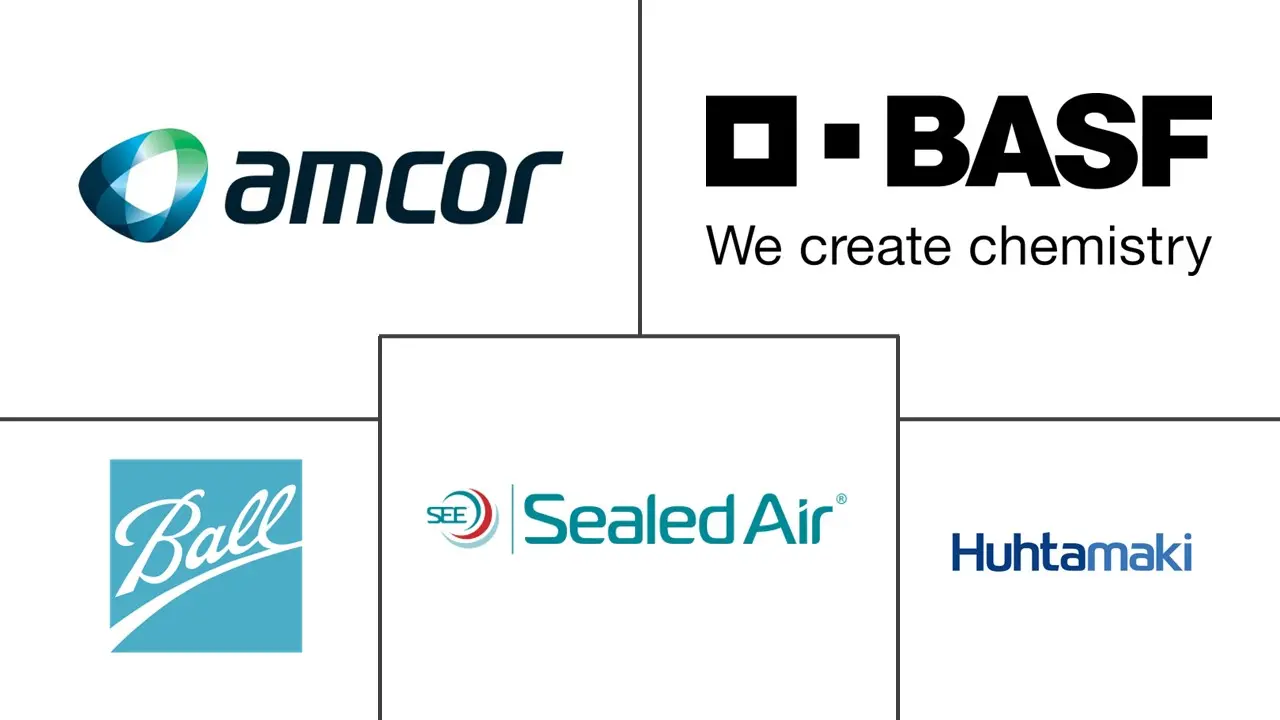Smart Packaging Market Size and Share
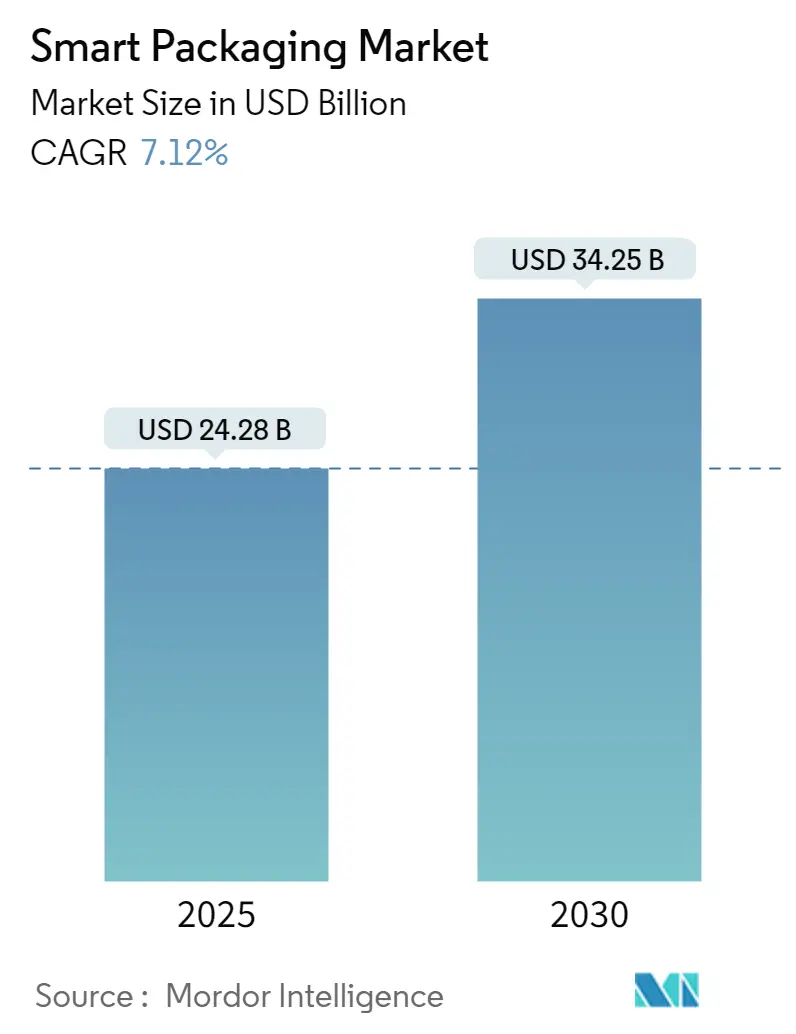
Smart Packaging Market Analysis by Mordor Intelligence
The Smart Packaging Market size is worth USD 24.28 Billion in 2025, growing at an 7.12% CAGR and is forecast to hit USD 34.25 Billion by 2030.
The smart packaging industry is experiencing a significant transformation driven by the increasing focus on sustainability and environmental consciousness. In December 2023, LMI Technologies demonstrated this shift by transitioning to 100% recyclable and biodegradable materials for all their product packaging, eliminating single-use plastics and foam materials. This eco-conscious approach has been coupled with technological integration, as evidenced by the incorporation of QR codes on packaging that provide instant access to product documentation and user guides, showcasing how sustainability can be merged with digital functionality.
The rise of e-commerce and changing consumer behaviors has revolutionized packaging requirements across industries. According to recent industry research by Zebra Technologies, investment in smart packaging technologies, including RFID packaging, sensors, and augmented reality, is expected to increase significantly, reaching 35% adoption by 2024, up from 29% in 2019. This transformation is particularly evident in the retail sector, where more than one in five companies are expected to utilize RFID and location technology for packaging (25%), inventory management (20%), and picking (19%) by 2024.
Food waste reduction has emerged as a critical driver for smart packaging innovation, with the United States alone witnessing approximately 133 billion pounds of food waste annually, valued at USD 161 billion. This has led to the development of sophisticated packaging solutions that can monitor freshness, control atmosphere, and extend shelf life. The industry has responded with advanced solutions such as time-temperature indicators, freshness monitors, and modified atmosphere packaging that can significantly reduce food spoilage.
The organic food sector has become a significant influencer in smart packaging development, with the United States organic packaged food market surpassing USD 21 billion in 2022. This growth has prompted packaging manufacturers to develop solutions that not only preserve organic product integrity but also provide transparency and traceability. Major retailers and food chains are increasingly adopting smart packaging solutions, as exemplified by Chipotle Mexican Grill's implementation of RFID packaging technology across its Chicago distribution center and approximately 200 restaurants to enhance inventory and traceability systems.
Global Smart Packaging Market Trends and Insights
Advancement in Technology in Food Packaging for Quality Inspection
The preservation of food products, their quality, and the assurance of food safety during shelf life have become paramount functions in the modern food industry. Smart food packaging sensors are revolutionizing quality control by monitoring crucial factors such as moisture, temperature, and oxygen levels. These technological advancements have enabled real-time monitoring and quality assurance throughout the supply chain. For instance, in July 2023, Engilico introduced cutting-edge solutions for inspecting, enhancing, and monitoring sealing processes, enabling improved packaging quality and end-of-line automation.
The Internet of Things (IoT) integration has transformed traditional packaging into adaptive intelligent packaging systems. Smart sensors, while seemingly a minor component of IoT, are revolutionizing industry operations. In September 2023, SICK launched its next-generation OD2000 distance sensor, combining high precision reliability with exceptional economy for various food and beverage processing and packaging applications. Additionally, Sealed Air's Prismiq digital packaging brand demonstrates the integration of digital technology with physical packaging, particularly in flexible food packaging, offering increased print flexibility and personalization options while enabling stronger consumer engagement through digital experiences.
Rising Awareness Regarding Food Safety
Food safety concerns have reached unprecedented levels, with the World Health Organization reporting that almost 1 in 10 people globally fall ill after eating contaminated food, resulting in 420,000 deaths annually and the loss of 33 million healthy life years. This has driven the development of active packaging solutions that can monitor and maintain food safety throughout the supply chain. The implementation of time-temperature indicators and freshness monitoring systems has become crucial in preventing foodborne illnesses and ensuring product quality.
Smart packaging is increasingly being utilized to combat food waste and ensure consumer safety. According to Industrial Packaging Inc., 40% of food in the United States ends up in landfills. However, innovative packaging features like time-temperature indicators, freshness indicators, and modified atmosphere packaging (MAP) can significantly reduce food waste and double the shelf life of perishable commodities. The implementation of RFID labels on food packaging has demonstrated remarkable results, including a 20% reduction in date-expired food waste, a 50% reduction in labor costs, and enabled high-speed retail checkout capabilities that are up to 15 times faster.
Development in the Printing Industry Due to Various Applications of Smart Packaging
The printing industry has undergone significant transformation to meet evolving packaging standards and consumer demands. Digital printing technologies are now being integrated with smart packaging solutions, creating new frameworks for intelligent packaging applications. In October 2023, Comexi announced the launch of Digiflex, a revolutionary device designed for flexible packaging and label converters for digital printing of variable data, including Datamatrix codes, QR codes, barcodes, and alphanumeric text. This innovation produces excellent results on quality tests and employs low-migration inks suitable for food packaging.
The advancement of printing technologies has enabled the integration of various smart packaging features into packaging materials. PrismiqTM, launched by Sealed Air, represents a significant advancement in digital packaging technology, featuring a portfolio of options for design services, digital printing, and connected packaging. The company has invested nearly USD 100 million in digital transformation, including the creation of the Prismiq 5540, the largest, fastest, and most versatile digital printing machine globally, capable of wide web, high-speed, full-color digital printing on flexible and shrinkable materials, including metallics and invisible ink.
Segment Analysis: By Technology
Active Packaging Segment in Smart Packaging Market
Active packaging dominates the smart packaging market, holding approximately 64% market share in 2024. This segment encompasses packaging solutions that interact with the contents to enhance freshness and extend shelf life through various mechanisms like humidity control, oxygen scavenging, and antimicrobial properties. Active packaging works through two primary mechanisms: either by placing active elements inside the package through small packets or envelopes, or by incorporating active components directly into the packaging material through extrusion, lamination, or printing processes. The technology has gained significant traction in the food and beverage industry, where it helps reduce food waste and maintain product quality. Active packaging builds upon traditional packaging concepts by adding functionality to adapt to protective functions and product needs, particularly in reducing destructive processes and extending shelf life during increased supply chain demands.
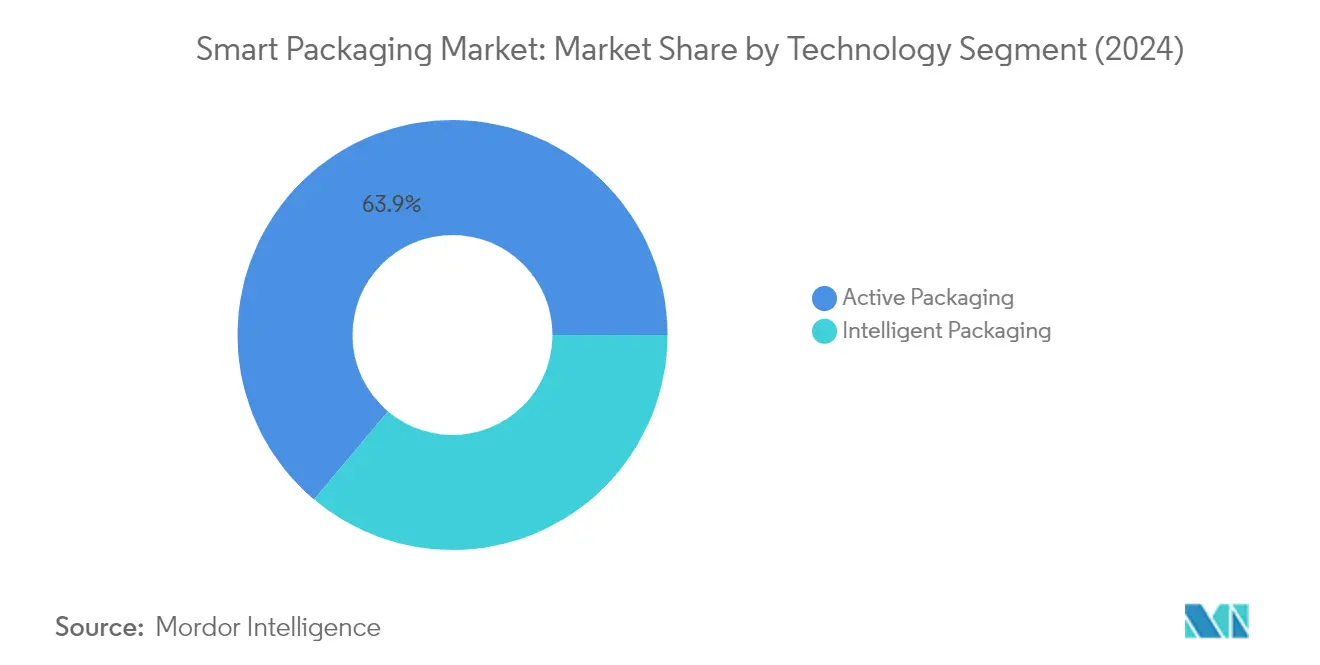
Intelligent Packaging Segment in Smart Packaging Market
The intelligent packaging segment is projected to experience the highest growth rate of approximately 8% during the forecast period 2024-2029. This growth is driven by the increasing adoption of sensor technology, RFID tags, and smart labels that enable real-time monitoring of product conditions. Intelligent packaging systems utilize various technologies, including printed codes, electronic and chemical sensors, and microchip-based solutions, to provide comprehensive data about each package. These advanced solutions offer capabilities such as temperature monitoring, tamper detection, and authentication features that are particularly valuable in pharmaceutical and food safety applications. The segment's growth is further accelerated by the rising demand for supply chain visibility, consumer engagement through connected packaging experiences, and the need for enhanced product security and authenticity verification in various industries.
Segment Analysis: By End-User Verticals
Food Segment in Smart Packaging Market
The food segment maintains its dominant position in the smart packaging market, commanding approximately 35% of the market share in 2024. This significant market presence is driven by the increasing demand for fresh, high-quality packaged food and manufacturers' growing interest in long-term food preservation solutions. Smart food packaging in the food sector employs an integrated approach with chemically and electrically controlled features that enable manufacturers to monitor shipping times, product freshness, and ensure safe handling and product quality. The segment's growth is further propelled by the exploration of nanotechnology in varied food applications, the demand for shelf-stable and sustainable packaging solutions among food retailers and manufacturers, and the increasing consumption of packaged food products. Food companies are increasingly embracing sensory marketing, appealing to various consumer senses, as it is not only the color or shape of a package that may affect a consumer's decision to buy it, but also its feel, sound, and even smell.
Personal Care Segment in Smart Packaging Market
The personal care segment is emerging as the fastest-growing sector in the smart packaging market, with a projected growth rate of approximately 8% during 2024-2029. This remarkable growth is driven by the increasing adoption of smart packaging solutions that provide accurate insights into stocks and inventory while making consumer behavior more predictable. Several personal care brands are incorporating new technologies to fulfill consumer requirements and provide innovative ways to keep consumers connected to their products. The segment is witnessing significant developments in sustainable and eco-smart collections that include ocean plastic, high-end mono-material, and refillable packaging solutions. Major companies are leveraging NFC technology to connect their products to the Internet of Things, offering exclusive content and personalized advice to customers through digital platforms. This technological integration is revolutionizing how consumers interact with personal care products, leading to enhanced customer engagement and brand loyalty.
Remaining Segments in End-User Verticals
The beverage and healthcare segments, along with other end-user verticals, continue to play crucial roles in shaping the smart packaging market landscape. The beverage industry relies heavily on enhanced packaging solutions that provide customers with real-time access to additional information and showcase sustainability credentials. The healthcare sector utilizes smart packaging to improve patient compliance, ensure product authenticity, and strengthen supply chain visibility. Other end-user verticals, including industrial applications, logistics, and the cannabis industry, are adopting smart packaging solutions for various purposes such as tracking components, ensuring proper maintenance of bulk containers, and implementing anti-counterfeiting measures. These segments collectively contribute to the market's diversification and innovation, driving the adoption of advanced packaging technologies across different industries.
Smart Packaging Market Geography Segment Analysis
Smart Packaging Market in North America
North America represents a mature smart packaging market for smart packaging solutions, driven by advanced technological infrastructure and high consumer awareness. The region demonstrates strong adoption across food, beverage, healthcare, and personal care sectors. Both the United States and Canada show significant market presence, with robust growth in applications like RFID technology, active packaging solutions, and intelligent packaging systems. The increasing focus on food safety, supply chain visibility, and sustainable packaging solutions continues to drive innovation in this region.
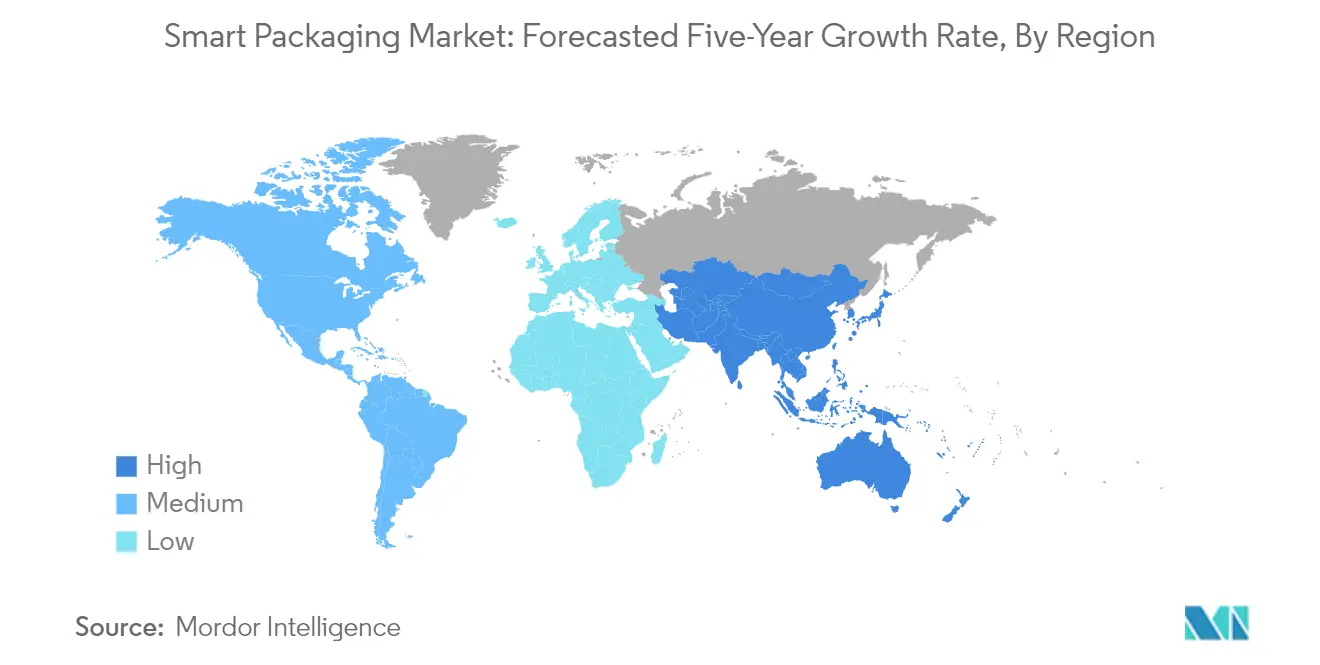
Smart Packaging Market in the United States
The United States dominates the North American smart packaging industry, benefiting from favorable regulatory conditions and a strong focus on sustainability. The country leads in implementing advanced packaging technologies across various end-user segments, particularly in the food and healthcare industries. With approximately 84% market share in North America in 2024, the United States demonstrates extensive adoption of active and intelligent packaging solutions. The pharmaceutical sector particularly shows strong growth potential, driven by the implementation of the Drug Supply Chain Security Act and increasing demand for track-and-trace solutions.
Smart Packaging Market in Canada
Canada emerges as the fastest-growing market in North America, with an expected growth rate of approximately 7% during 2024-2029. The country's smart packaging market is experiencing rapid evolution, particularly in food and pharmaceutical applications. The Canadian Printable Electronics Industry Association's initiatives, including the IntelliPACK Leadership Council, are fostering innovation in intelligent packaging solutions. The market shows particular strength in areas such as temperature monitoring systems, freshness indicators, and smart labels, supported by increasing awareness of food safety and sustainability concerns.
Smart Packaging Market in Europe
Europe represents a sophisticated smart packaging market for smart packaging solutions, characterized by strong environmental consciousness and technological innovation. The region encompasses diverse markets including Germany, the United Kingdom, and France, each contributing uniquely to the sector's growth. European countries are particularly focused on reducing food waste through smart packaging solutions, supported by various EU initiatives and regulations. The region shows strong adoption of advanced technologies like RFID, NFC, and intelligent labels across various industries.
Smart Packaging Market in the United Kingdom
The United Kingdom leads the European smart packaging industry, with approximately 27% regional market share in 2024. The country's market is primarily driven by strong adoption in the food, beverage, and pharmaceutical industries. British retailers and brands are increasingly embracing smart packaging solutions to enhance consumer engagement and product traceability. The market shows particular strength in areas such as temperature monitoring, freshness indicators, and interactive packaging solutions, supported by growing consumer awareness and technological advancement.
Smart Packaging Market in France
France demonstrates the highest growth potential in the European region, with an expected growth rate of approximately 6% during 2024-2029. As the world's most sustainable country for food, France is actively embracing smart packaging solutions to reduce food waste and enhance product safety. The country's packaging industry is witnessing significant progress in terms of design and production, particularly driven by initiatives like Smart Factory and Industry 4.0. The market shows strong potential in areas such as RFID implementation, wireless ID solutions, and connected packaging experiences.
Smart Packaging Market in Asia-Pacific
The Asia-Pacific region represents a dynamic and rapidly evolving smart packaging market for smart packaging solutions, encompassing diverse economies including China, Japan, and India. The region demonstrates strong growth potential driven by increasing urbanization, rising consumer awareness, and technological advancement. Each country in the region brings unique strengths to the market, with varying levels of adoption across different industry verticals. The region shows particular strength in areas such as active packaging, intelligent labels, and RFID solutions.
Smart Packaging Market in China
China leads the Asia-Pacific smart packaging market, driven by its massive pharmaceutical market and growing focus on food safety. The country's smart packaging sector benefits from rapid technological advancements and strong government support through initiatives like 'Made in China 2025'. The market shows particular strength in areas such as pharmaceutical packaging, food waste reduction solutions, and supply chain management systems.
Smart Packaging Market in India
India emerges as the fastest-growing market in the Asia-Pacific region, driven by changing consumer buying patterns and increasing awareness about hygiene-conscious products. The country's smart packaging sector is witnessing significant transformation, particularly in food and pharmaceutical applications. The market shows strong potential in areas such as active packaging solutions, smart labeling techniques, and QR code implementation, supported by government initiatives and increasing technological adoption.
Smart Packaging Market in Latin America
Latin America represents an emerging smart packaging market for smart packaging solutions, characterized by rich production of raw materials and food goods. The region demonstrates increasing adoption of smart packaging technologies, particularly in the meat processing and retail sectors. Brazil emerges as both the largest and fastest-growing market in the region, driven by significant investments in RFID technology and increasing e-commerce adoption. The region shows particular strength in areas such as active packaging, intelligent labels, and supply chain management solutions, supported by growing urbanization and changing consumer preferences.
Smart Packaging Market in the Middle East & Africa
The Middle East & Africa region presents unique opportunities for smart packaging solutions, driven by diverse market needs across different countries. The region demonstrates growing adoption of smart packaging technologies, particularly in food and beverage applications. The United Arab Emirates emerges as the largest market, while South Africa shows the fastest growth potential. The region shows particular strength in areas such as temperature monitoring systems, active packaging solutions, and smart labels, supported by increasing focus on food safety and product authenticity.
Competitive Landscape
Top Companies in Smart Packaging Market
The smart packaging market features prominent players like Sealed Air Corporation, Amcor PLC, Ball Corporation, BASF SE, Huhtamaki OYJ, Stora Enso, Avery Dennison, Zebra Technologies, 3M Company, and International Paper Company. These smart packaging companies are driving innovation through significant investments in R&D, particularly focusing on RFID technology, digital watermarking, and connected packaging solutions. Market leaders are emphasizing sustainability alongside smart features, developing recyclable and reusable packaging materials with integrated digital capabilities. Companies are expanding their geographical presence through strategic acquisitions and partnerships, particularly in emerging markets, while simultaneously strengthening their digital infrastructure and manufacturing capabilities. The industry is witnessing a strong trend toward cloud-based platforms and end-to-end solutions that combine physical packaging with digital experiences, enabling enhanced customer engagement and supply chain visibility.
Global Leaders Drive Market Consolidation Trends
The smart packaging industry exhibits a moderately consolidated structure dominated by multinational conglomerates with diverse product portfolios spanning multiple packaging segments. These global leaders leverage their extensive R&D capabilities, manufacturing infrastructure, and distribution networks to maintain market leadership, while regional specialists focus on niche applications and local market requirements. The competitive landscape is characterized by a mix of established packaging companies expanding into smart solutions and technology firms entering the packaging space through innovative offerings.
The market is experiencing increased consolidation through strategic mergers and acquisitions, as companies seek to enhance their technological capabilities and expand their geographical footprint. Major players are acquiring smaller, innovative companies to access new technologies and enter emerging market segments, particularly in digital printing, RFID solutions, and smart packaging solutions. Companies are also forming strategic partnerships with technology providers and research institutions to accelerate innovation and develop comprehensive smart packaging solutions that address evolving customer needs.
Innovation and Adaptability Drive Future Success
Success in the smart packaging industry increasingly depends on companies' ability to develop integrated solutions that combine physical packaging with digital capabilities while maintaining cost-effectiveness and sustainability. Market leaders are focusing on building comprehensive ecosystems that include cloud platforms, mobile applications, and analytics capabilities alongside traditional packaging solutions. Companies must also navigate the growing concentration of end-users in key sectors like food and beverage, healthcare, and e-commerce, while addressing concerns about data security and privacy in smart packaging solutions.
Future market share gains will require companies to demonstrate strong technological innovation capabilities while maintaining operational efficiency and supply chain resilience. New entrants and challenger brands can gain ground by focusing on specific industry verticals or regional markets where they can offer specialized solutions and superior customer service. The regulatory landscape, particularly regarding sustainability and data privacy, will continue to shape market dynamics, requiring companies to maintain flexibility in their product development and business strategies. Success will also depend on companies' ability to address the increasing demand for sustainable solutions while managing the cost implications of incorporating smart packaging technologies.
Smart Packaging Industry Leaders
-
Sealed Air Corporation
-
Amcor PLC
-
Ball Corporation
-
BASF SE
-
Huhtamaki OYJ
- *Disclaimer: Major Players sorted in no particular order
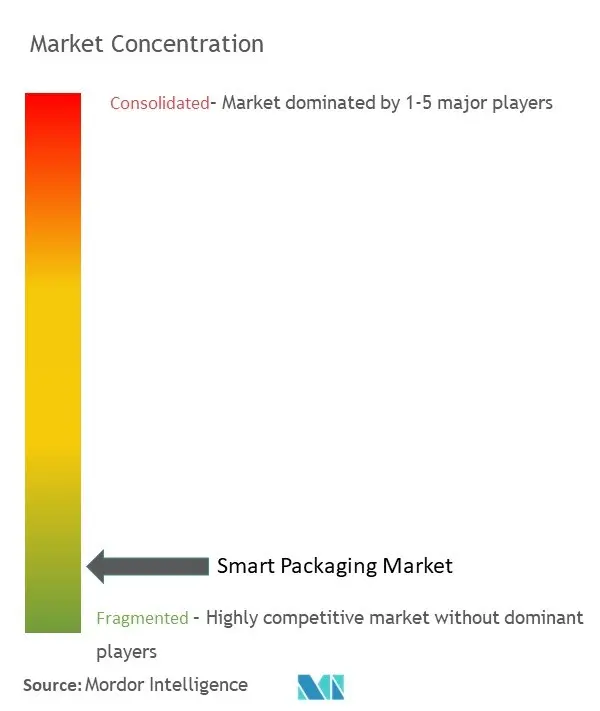
Recent Industry Developments
- June 2024: Myprotein, a significant online sports nutrition brand in India, strengthened its dedication to the Indian market. It announced a pioneering feature, the 'Authentication QR Code,' empowering consumers to validate their purchases swiftly. This QR code grants access to crucial details like authenticity, country of origin, expiration date, and batch number.
- October 2023: Appetite Creative, a digital technology studio, partnered with Tetra Pak, a packaging company, to introduce innovative interactive smart packaging for Rauch, a European fruit juice producer. This smart packaging was designed to complement Rauch's winter drink theme.
Global Smart Packaging Market Report Scope
Smart packaging refers to systems with embedded sensor technology used with foods, pharmaceuticals, and many other products.
The smart packaging market is segmented by technology (active packaging and intelligent packaging), end-user vertical (food, beverage, healthcare, and personal care), and geography (North America (the United States and Canada), Europe (Germany, the United Kingdom, France, and Rest of Europe), Asia-Pacific (China, Japan, India, and Rest of Asia-Pacific), Latin America, and Middle East and Africa). Factors affecting the market's evolution in the near future, such as drivers and constraints, have been covered in the study. The market sizes and forecasts are provided in terms of value (USD) for all the above segments.
| Active Packaging |
| Intelligent Packaging |
| Food |
| Beverage |
| Healthcare |
| Personal Care |
| Other End-user Verticals |
| North America | United States |
| Canada | |
| Europe | Germany |
| United Kingdom | |
| France | |
| Rest of Europe | |
| Asia-Pacific | China |
| Japan | |
| India | |
| Rest of Asia-Pacific | |
| Latin America | |
| Middle East and Africa |
| By Technology | Active Packaging | |
| Intelligent Packaging | ||
| By End-user Vertical | Food | |
| Beverage | ||
| Healthcare | ||
| Personal Care | ||
| Other End-user Verticals | ||
| By Geography | North America | United States |
| Canada | ||
| Europe | Germany | |
| United Kingdom | ||
| France | ||
| Rest of Europe | ||
| Asia-Pacific | China | |
| Japan | ||
| India | ||
| Rest of Asia-Pacific | ||
| Latin America | ||
| Middle East and Africa | ||
Key Questions Answered in the Report
How big is the Smart Packaging Market?
The Smart Packaging Market size is worth USD 24.28 billion in 2025, growing at an 7.12% CAGR and is forecast to hit USD 34.25 billion by 2030.
What is the current Smart Packaging Market size?
In 2025, the Smart Packaging Market size is expected to reach USD 24.28 billion.
Which is the fastest growing region in Smart Packaging Market?
Asia Pacific is estimated to grow at the highest CAGR over the forecast period (2025-2030).
Which region has the biggest share in Smart Packaging Market?
In 2025, the North America accounts for the largest market share in Smart Packaging Market.
What years does this Smart Packaging Market cover, and what was the market size in 2024?
In 2024, the Smart Packaging Market size was estimated at USD 22.55 billion. The report covers the Smart Packaging Market historical market size for years: 2019, 2020, 2021, 2022, 2023 and 2024. The report also forecasts the Smart Packaging Market size for years: 2025, 2026, 2027, 2028, 2029 and 2030.
Page last updated on:
